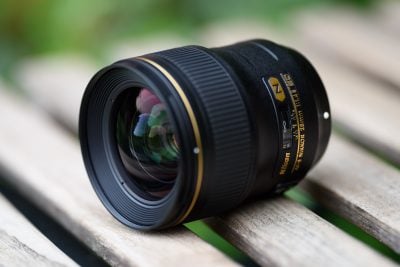Nikon 28mm f1.4E review
-
-
Written by Thomas
Quality
Longitudinal Chromatic Aberration and focus shift
A focal ratio of f1.4 for the new Nikon lens makes testing for longitudinal color aberrations (loCA, a.k.a. “axial color” or “bokeh CA”) mandatory. These would show up as magenta coloration in the foreground and greenish hues in the background and are not easily corrected in post-processing. The following image shows that Nikon’s new lens has some loCA but not so bad as I’ve seen from other f1.4 lenses:
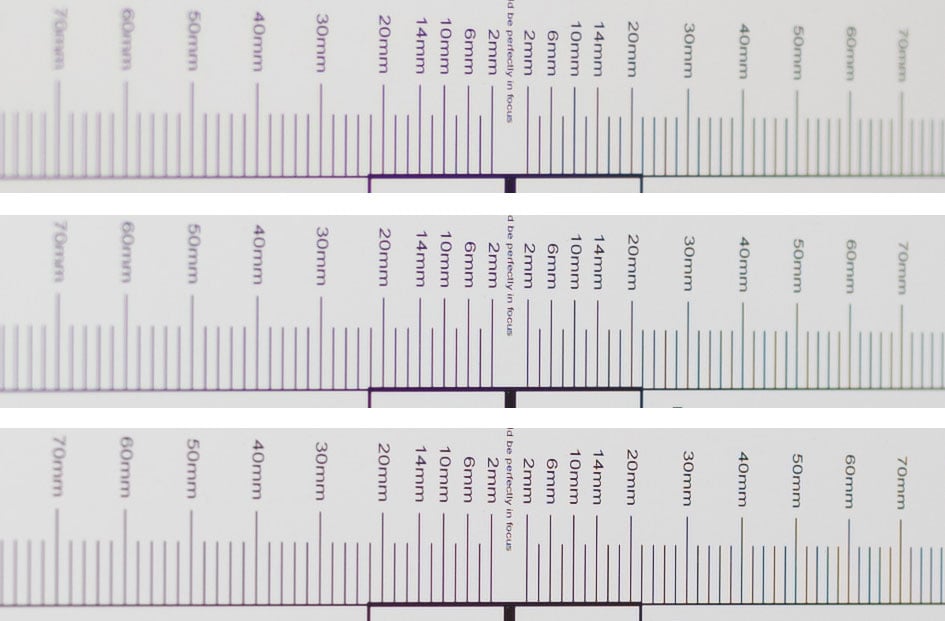
Above: Nikon 28/1.4E Longitudinal Chromatic Aberration (loCA). 100% crop, at f1.4 (top), f2.0 (middle), f2.8 (bottom); left = foreground, right = background
The magenta coloration in the foreground is more prominent than the green in the background especially compared to the Otus:
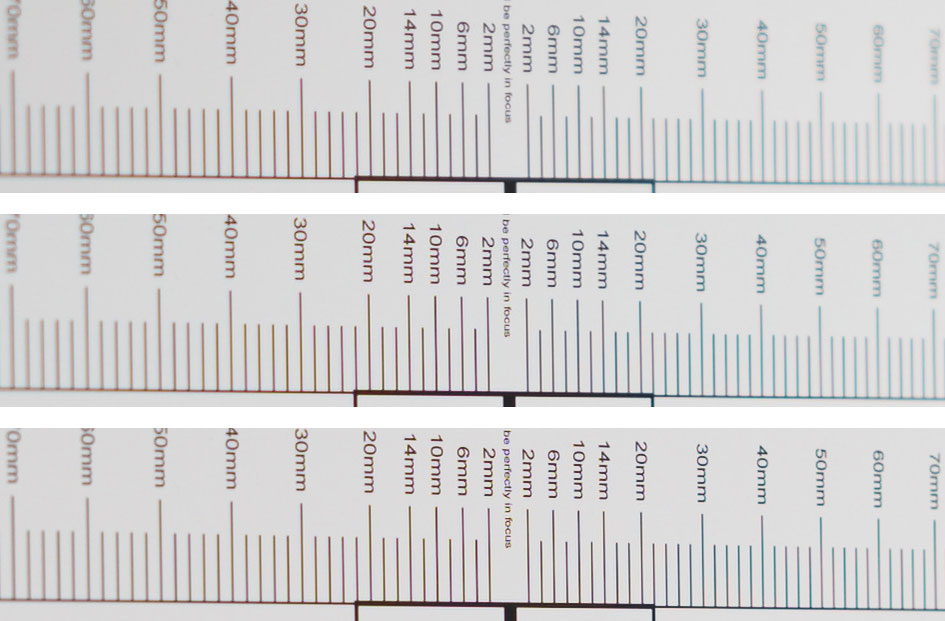
Above: Zeiss 28/1.4 Otus Longitudinal Chromatic Aberration (loCA). 100% crop, at f1.4 (top), f2.0 (middle), f2.8 (bottom); left = foreground, right = background
This test also revealed no discernible focus shift.
Sharpness and contrast
Let’s have a look at the theoretical performance of the new lens compared to the Otus:
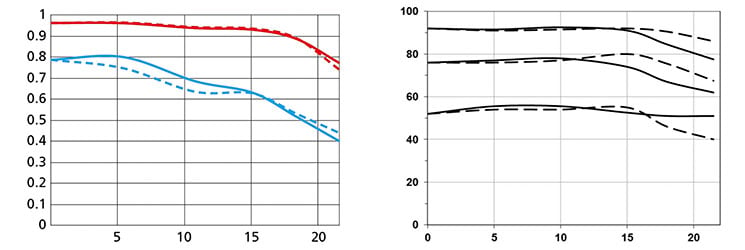 Above: Nikon 28/1.4E MTF (left), Zeiss 28/1.4 Otus (right)
Above: Nikon 28/1.4E MTF (left), Zeiss 28/1.4 Otus (right)
These charts show the lens-performance of both lenses at f1.4. To read these charts you need to know that higher values are better and the closer the line-pairs are together the less astigmatism (= resolution depends on the orientation of the test-pattern) the lens has. The x-axis displays the distance from the optical axis (=center of the sensor) in mm. Nikon shows the calculated contrast without influence of diffraction at 10 line-pairs per mm (read lines) and 30 lp/mm (in petrol) while Zeiss shows the measured contrast from a real lens (thus including the softening effects of diffraction) at 10 lp/mm (upper curve pair), 20 lp/mm (middle), and 40 lp/mm (lower).
From the charts, the new Nikon should have a very high overall contrast even wide open. But resolution of fine detail rolls off first towards the DX-corner and further towards the FX-corner while the Zeiss produces a very even resolution across the frame. Both lenses have very little astigmatism. But let’s see how this theoretical performance translates into real life results in the sharpness test based on Siemens-stars.
In what follows I’ll show you the real-life performance at 4 mm (“center”), 13 mm (“APS-C/DX-corner”), and 20 mm (“FF/FX-corner”) distance from the optical axis on a 36MP Nikon D810 body. Processing was done in Lightroom 6.10 from RAW at Camera Standard settings with no extra tone, color, or saturation-adjustment. Noise-reduction is set to 0, sharpening to 35/0.5/36/10. White-balance was adjusted to a neutral white and I did some exposure compensation to make the brightness of all crops match. So you will not see light fall-off in the corners in this test. Removal of lateral CAs is ON but no lens profile was used.
The following are all 100% crops!
Nikon 28/1.4E on Nikon D810; 100% crop from center, DX-corner, FX-corner

Above: 28mm, f1.4

Above: 28mm, f2.0

Above: 28mm, f2.8

Above: 28mm, f4.0

Above: 28mm, f5.6

Above: 28mm, f8.0

Above: 28mm, f11

Above: 28mm, f16
These 100% crops directly from a 36MP D810 sensor show an excellent performance of this lens in the center right from f1.4. But the DX-corner and FX-corner show visible softening that is not fully remedied until stopping down to f5.6. The center and DX-corner crops for any aperture were taken from the same shot as there is no discernible field curvature within the DX image-circle at this distance. But the FX-corner had to be focused slightly different to achieve optimal resolution. The effect of diffraction can be seen even at f8 in the center. Distortions are pretty low.
The following comparison shows the Nikon 28/1.4E (1st row) and the Zeiss 28/1.4 Otus (2nd row) at f1.4:

Above: Nikon 28/1.4E at 28mm, f1.4

Above: Zeiss Otus 28/1.4 at 28mm, f1.4
In this comparison the Otus is the clear winner on the DX- and FX-corner although the Nikon looks a tiny bit better in the center.
Performance at long distances
This is a series of test-shots of a cityscape where you can measure distances in km, not meter. I use this scene to show you how the lenses perform when almost everything is at infinity. I set White Balance to a standard daylight value to make them comparable across lenses shot at the same day and also try to make exposure comparable. There’s no tinkering with vignette-control so you see it here as it is produced by the lens. Focus was manually acquired at the largest aperture in live-view and not changed for other apertures.
You can click on the main image or the crops to access the respective large original or you use the links beneath the main image. Please respect our copyright and only use those images for personal use.
The main image shows the complete scene at f1.4 to give you an impression of the angle of view and to judge vignetting. This is followed by one row of 100% crops from f1.4 to f11 each from the middle, the DX-corner and the FX-corner.
Nikon 28/1.4E shot with Nikon D810
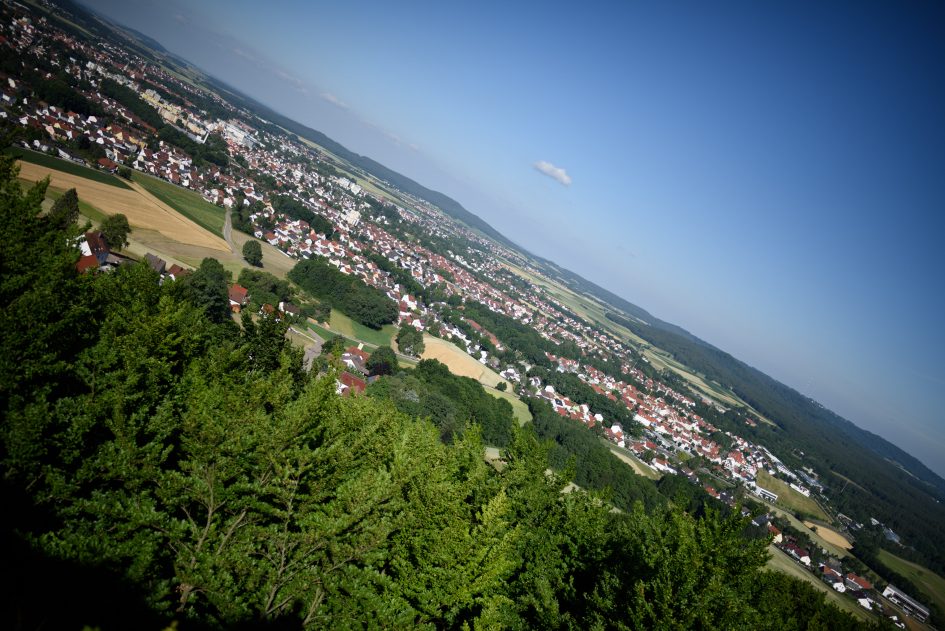
Above: 28mm, f1.4; also available at f1.8, f2.0, f2.8, f4.0, f5.6, f8.0, f11, f16

Above: 28mm, f1.4

Above: 28mm, f2.0

Above: 28mm, f2.8

Above: 28mm, f4.0

Above: 28mm, f5.6

Above: 28mm, f8.0

Above: 28mm, f11
In this long distance test the new Nikon again shows its merit: its performance in the center is flawless and the FX-corner is very good. Only the DX-corner is a bit soft even at f2.0. And the amount of vignetting is pretty strong until you stop down to f2.8.
I shot the same scene within minutes with the Zeiss 28/1.4 Otus for comparison:

Above: Nikon 28/1.4E at f1.4

Above: Zeiss 28/1.4 Otus at f1.4; also available at f1.8, f2.0, f2.8, f4.0, f5.6, f8.0, f11, f16
I’d say that both lenses look pretty similar in this shot. If you look closely the Nikon is a bit sharper in the center than the Otus but softer in the DX-corner. In the FX-corner the light fall-off masks a bit that the Nikon shows some magenta haloing at high contras edges which the Otus is free of.
Rendering of point-light sources at night-shots
Night-shots pose a different challenge for lenses as the contrast is even higher than under bright sun and point-light sources can reveal some weaknesses such as coma, haloing and color-aberrations that do not show up as prominently in other test-shots. The 100% crops below the main image show the effect of coma in the FX-corner of the Nikon and the Zeiss at various apertures:
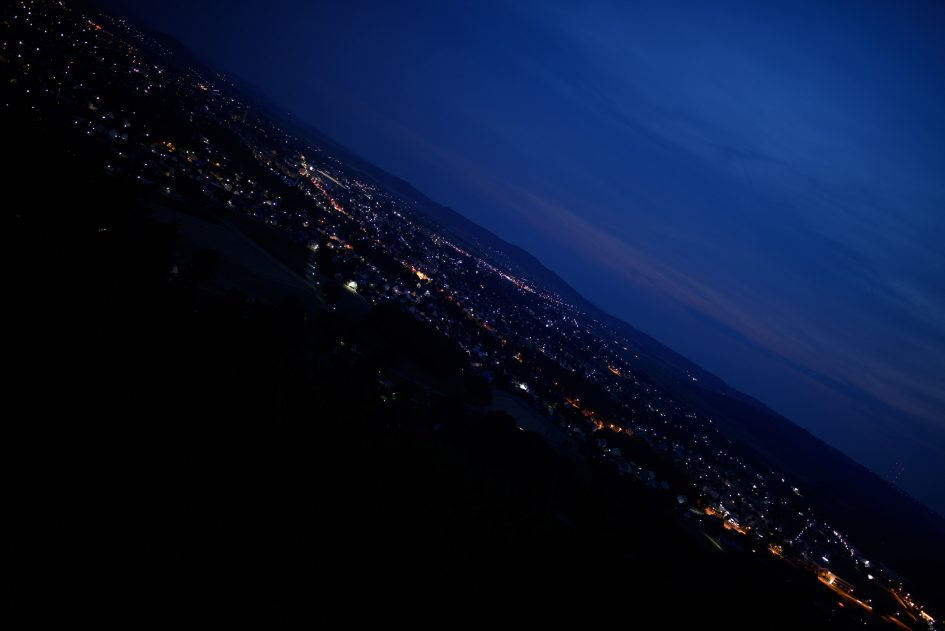
Above: Nikon 28mm f1.4E at f1.4; also available at f2.0, f2.8, f4.0, f5.6, f8.0

Above: Nikon 28mm f1.4E; FF/FX-corner at f1.4 (left), f2.0 (middle), f2.8 (right)

Above: Zeiss 28mm f1.4 Otus; FF/FX-corner at f1.4 (left), f2.0 (middle), f2.8 (right); also available at f4.0, f5.6, f8.0
The new Nikon shows only little coma even wide open. The coma of the Otus is just a tad larger but is more color neutral. The Nikon renders lights with a small (but visible) magenta halo. And that all across the sensor. This effect is also visible in daylight shots where dark lines or edges against a bright background (like twigs in front of the sky) show magenta ghosting. See the following 100% crop:

Above: Nikon 28mm f1.4E at f1.4; 100% crop from center
Rendering of out-of-focus point-light sources and Bokeh
This test is for the rendering of point-light sources in an out-of-focus background. The circle of confusion that is produced by this test is pretty indicative of Bokeh performance (in the background) and light fall-off. Ideally the out-of-focus image of the point-light is evenly lit and perfectly circular, with no “onion-rings” or outlining, and without coloration. Large aperture lenses normally produce an effect known as “cat’s eye” the further away from the optical axis the point-light is projected. This is due to optical vignetting in the lens barrel when light enters the lens from an angle.
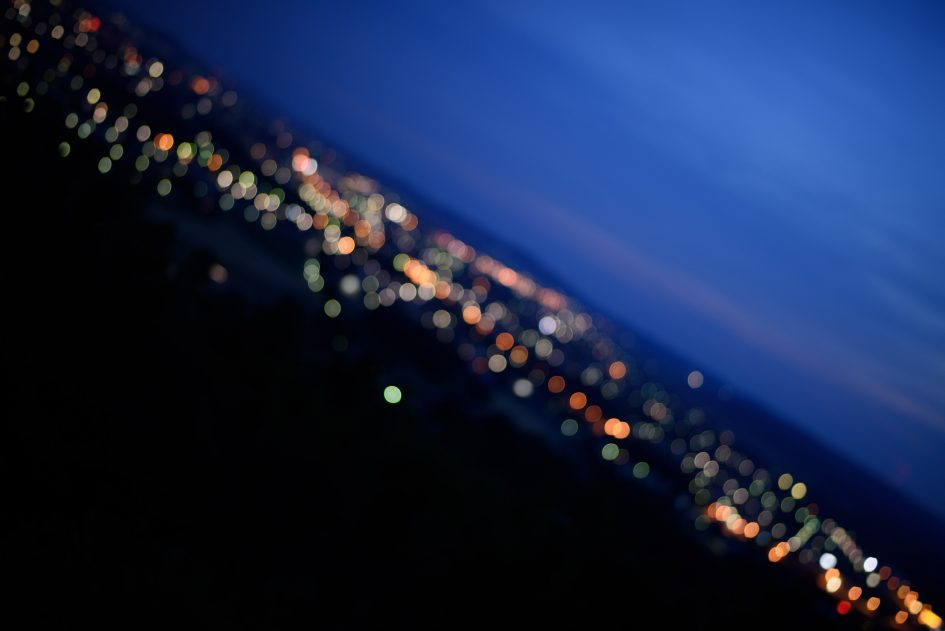
Above: Nikon 28/1.4E at f1.4; also available at f2.0, f2.8, f4.0, f5.6, 8.0

Above: Nikon 28/1.4E at f1.4; 50% crops from center, DX-corner, FX-corner

Above: Zeiss 28/1.4 Otus at f1.4; 50% crops from center, DX-corner, FX-corner; also available at f2.0, f2.8, f4.0, f5.6, f8.0
Both lenses look pretty similar in this shot. The Bokeh balls are of similar size and get distorted in a similar way towards the corners of the sensor. A closer look reveals that the Nikon has slight outlining in green with weak onion rings and a slight pattering of the circles of confusion in the center while the Otus shows pretty strong outlining (but no coloration). Towards the corners of the sensor the Nikon develops stronger outlining while the Otus reduces its outlining but shows a stronger patterning of the Bokeh balls.
Let’s see how this analysis of out-of-focus point-light sources translates into Bokeh-performance shooting a bookshelf:
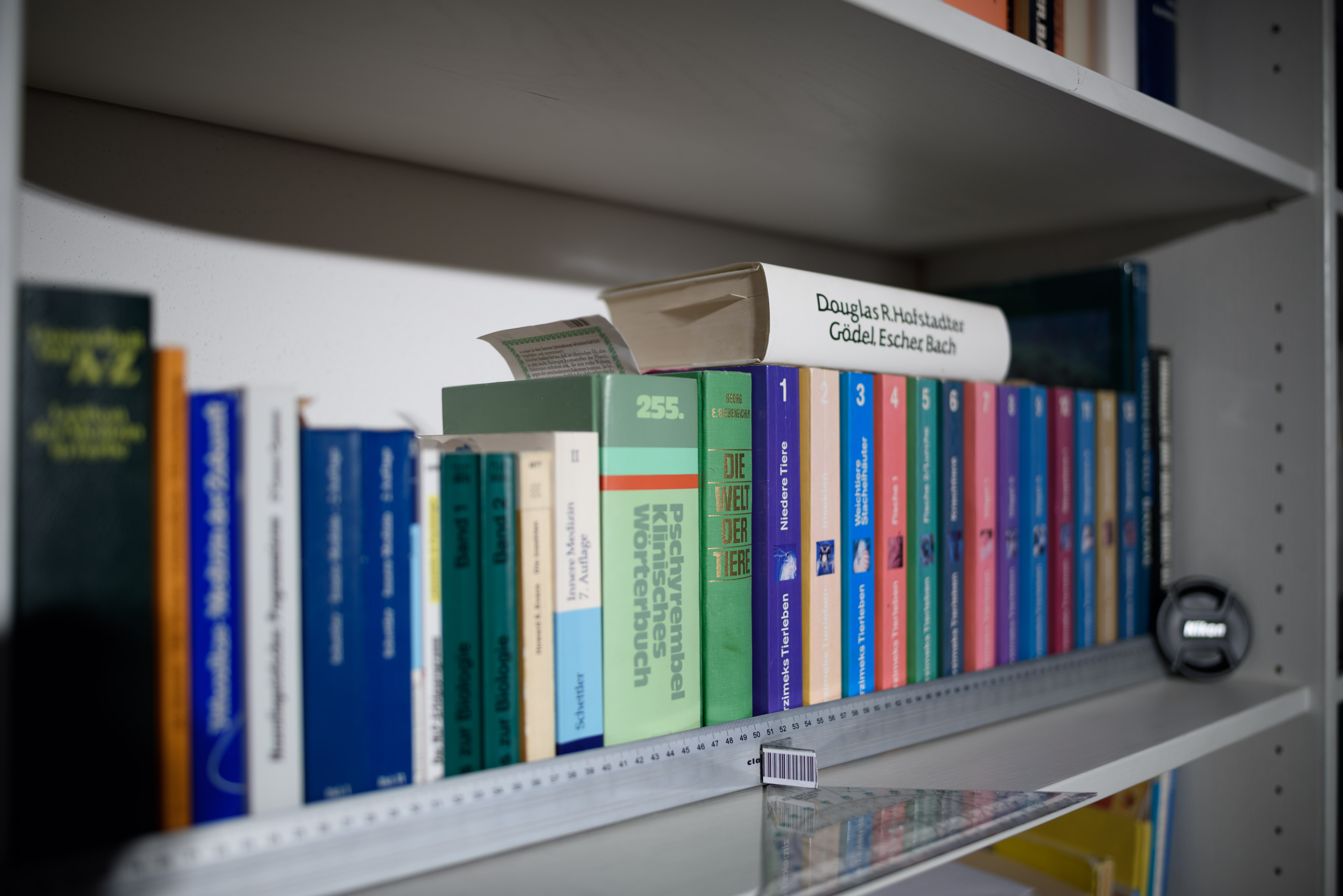
Above: Nikon 28/1.4E at f1.4; also available at f1.8, f2.0, f2.8, f4.0, f5.6, f8.0

Above: Nikon 28/1.4E at f1.4; 50% crops from foreground, middle-ground, background

Above: Zeiss 28/1.4 Otus at f1.4; 50% crops from foreground, middle-ground, background; also available at f1.8, f2.0, f2.8, f4.0, f5.6, f8.0
Wide-angle lenses are not known for their beautiful Bokeh. But the new Nikon certainly produces one of the best Bokehs of any 28mm lens. In the transition zone and the background it renders even a bit softer than the Otus, albeit with a slight greenish tinge in the middle-ground from longitudinal CAs.
Flare, ghosting, and sun-stars
A strong light-source shining directly into the lens could produce strange colorful ghosts-images or reduce contrast considerably through flare and glare. The appearance of flare and ghosting depends on factors like the aperture and the angle of the light hitting the lens. So to judge the proclivity of the new Nikon for these artifacts I went through a series of well calculated shots against a strong light source to provoke flare, glare, and ghosting.
The 28/1.4 stays quite clear of artifacts wide open with a small and weak ghost developing when the light-source is near the center. At f8 there is more to be seen: The lens produces beautiful sun-stars and it still shows only little ghosting (left image below). But with the light-source in the DX-corner (or there-abouts) the lens develops a heavy magenta flare (right image below).
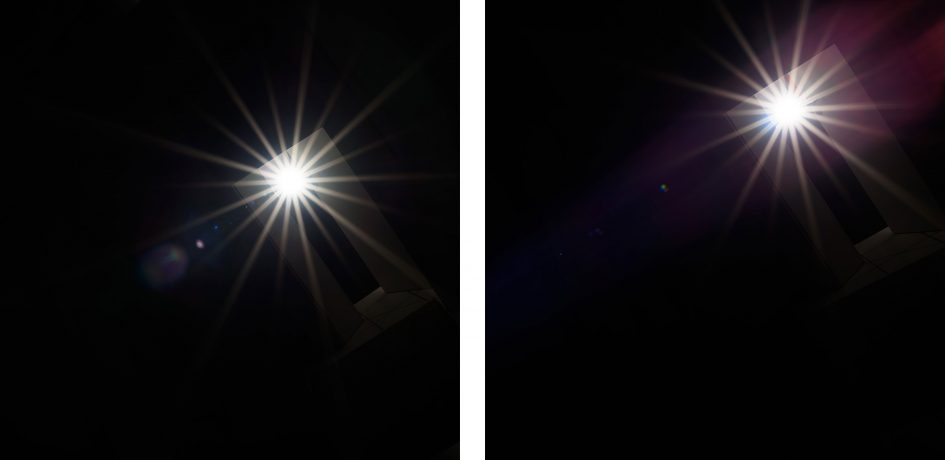
Above: Strong light hitting the Nikon 28/1.4E at f8.0, crops
Interestingly the Otus produces a similar flare. Outside the artifacts the new Nikon produces very deep blacks even in strong contra light. All-in-all these results are very good – indeed a little better than from the Zeiss Otus:
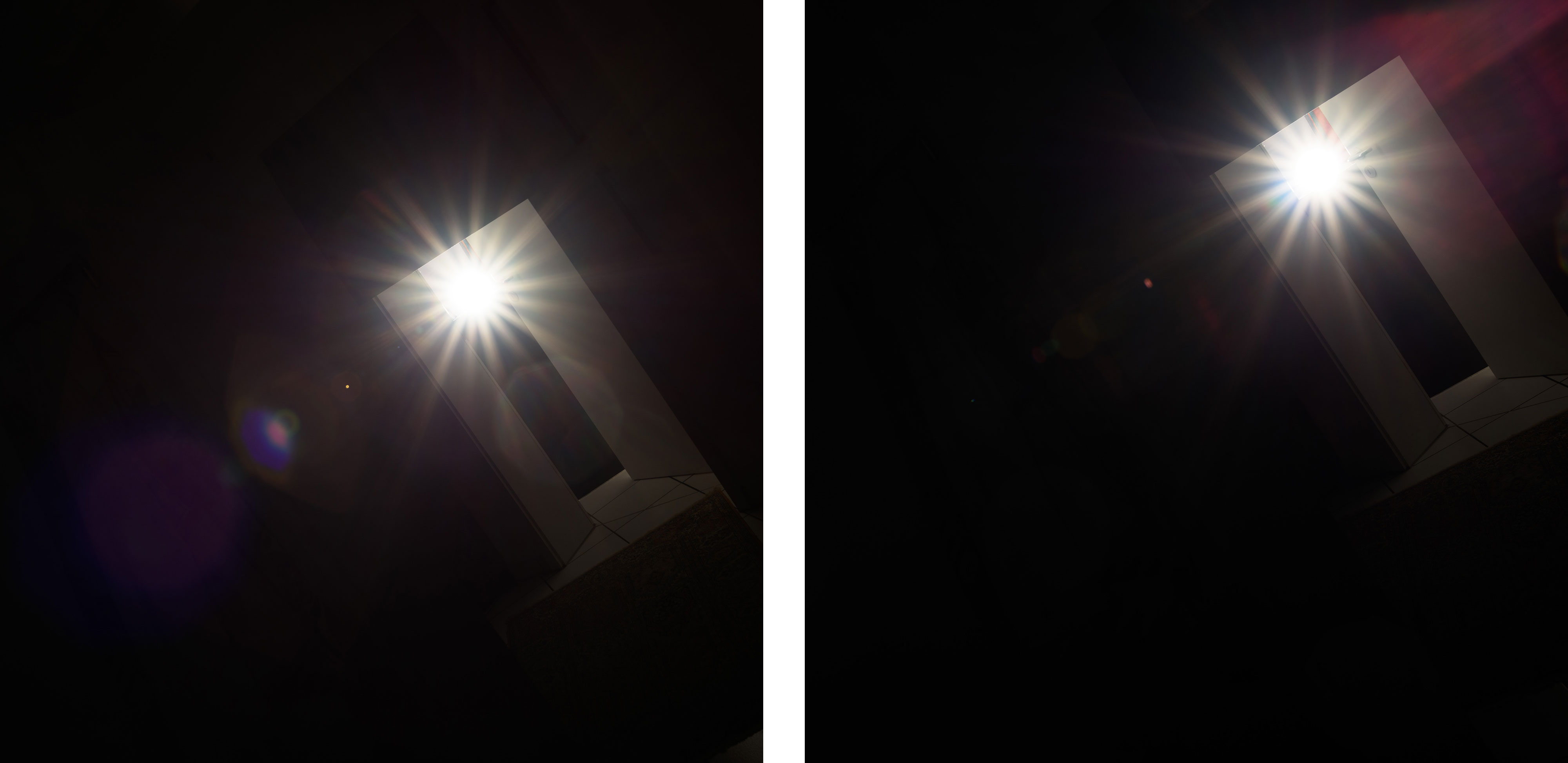
Above: Strong light hitting the Zeiss Otus 28/1.4 at f8.0, crops
Check prices on the Nikon 28mm f1.4E at Amazon, B&H, Adorama, or Wex. Alternatively get yourself a copy of my In Camera book or treat me to a coffee! Thanks!



